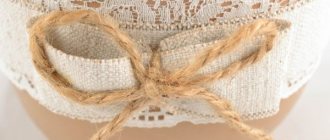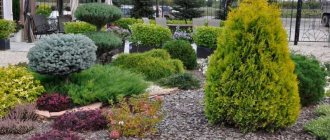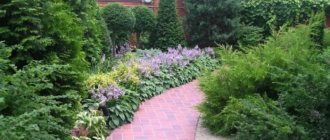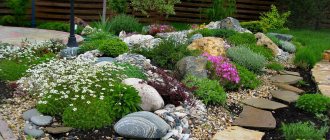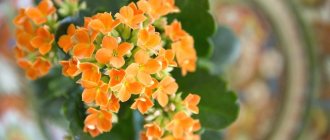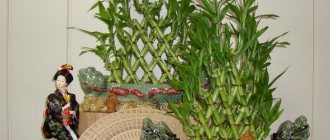Ideas for using hedges
Landscape designers use green spaces as low borders. It emphasizes the curves of paths and architectural objects, flower beds and fountains. Living decoration is also suitable for decorating a pond or playground. What is the best hedge to use as a border:
- cowberry;
- Thunberg barberry;
- boxwood;
- Lawson cypress;
- dwarf caragana.
A “border” of plants.
On a large area, plantings can be used to zone the space. Separate the recreation area from the garden or vegetable garden. Designers advise choosing shrubs with a height of up to a meter. This will avoid creating unnecessary shadow. Planted in parallel, symmetrically, wavy.
Standard rectangular shapes surprise no one. Shrubs for hedges can take a variety of shapes. Even a novice gardener can do cubes, arches, waves. Masters of their craft embody images of animals using garden shears. Such compositions require frequent maintenance.
Designer flower beds
Using plantings as a design accent is a great option. Colorful multi-level structures transform any area. Red-leaved boxwood and blue spruce are often combined. To maintain an attractive appearance, experts recommend choosing perennial plants of a contrasting shade.
If the area looks bland, then it is good to use flowering plants. Spiraea, currant and hawthorn bloom from several weeks to a month. By combining large plants with low borders, you can get compositions that bloom all year round.
Properly selected plants are the key to beautiful flower beds all year round
Eclecticism is trending not only on fashion catwalks. Hedging bushes are combined not only with sculptural compositions. The following solutions also apply:
- gabions;
- large stones;
- boulders;
- fences;
- wooden modules;
- brick pillars.
Green plants will help “restore” an old fence. Climbing or tall plants are useful for this purpose. The wire structure will allow you to create a hedge of clematis, hydrangea, honeysuckle, grapes and wisteria. Climbing roses are especially beautiful.
Path of roses
See also: Catalog of companies that specialize in landscaping work on sites.
Types of hedges
A hedge is a kind of “flower bed”, a planting of plants that serves to designate a specific area or to protect it. Often it also performs an aesthetic function. A hedge is traditionally created from shrubs or trees, but you can find natural barriers made of grasses and even vines, but these usually still serve to complement and decorate more durable options for a plant “fence”.
Tall hedge
Hedge in the garden
The history of hedges dates back centuries, so it is not surprising that they come in a large number of varieties of shapes and sizes. First of all, they are classified by height.
Hedge
Table. Classification of barriers depending on height.
| Type name | Height, m | Description |
| Border | Up to 1 | This is the lowest version of a living barrier, a kind of discount. Typically used to frame garden beds, paths, paths. Crops used for cultivation include heather, Japanese quince, alpine currant, rose hips, and sea buckthorn. The most important thing is that the plants are slow-growing, small and have small leaves. |
| Average height | 1-3 | To create such hedges, shrubs and - sometimes - low trees are used. For example, mock orange, barberry, western thuja, acacia, euonymus, juniper, lilac and others are excellent. Typically, such hedges advantageously divide the garden into sections - this is exactly what they are used for. |
| Living wall | More than 3 | Such living “fences” are real defenders of the garden plot from wind, noise, dust and exhaust gases from highways. Willow, spruce, thuja, hornbeam, and apple trees are used to grow such walls. The main thing is that the trees are of a species that can easily tolerate pruning. Such hedges are planted along the perimeter of the site. |
Low-growing decorative hedge
Note! Almost each of these options will combine quite harmoniously with stone and iron. That is why often living fences are not continuous - some of their sections are an ordinary, not natural fence.
Beautiful hedge
Another “size” option for classifying hedges is their row or width.
- Single-row - in this case, all the plants forming the hedge are planted in one row and at an equal distance.
- Double-row - respectively, have two rows of plants planted in several lines, most often in tiers.
- Multi-row - three or more rows of plants. Usually in this case, crops are planted in a checkerboard pattern, taking into account the distance from the trunks and crowns in the future. Multi-tiered hedges are often made cascading.
Multi-level 2-row hedge
TOP fast-growing shrubs for creating a hedge
In landscape design, a “fence” of green spaces is usually divided into two types: formalized and unformed. The latter is used extremely rarely, as it gives the site a neglected appearance. Fast-growing hedge shrubs will transform your landscape in a short time.
- Dogwood , with proper care, reaches 3-4 meters in height. It blooms from March to April, then blooms leaves and fruits. A well-lit area is suitable for growing. When buying an annual plant, you need to understand that dogwood grows slowly, and a two-year-old seedling grows more actively.
Dogwood hedge
- The bladderwort is unpretentious in care. It is important that the water at the roots does not stagnate, otherwise the plant will die. It reaches four meters in height, but dwarf shrubs up to a meter are suitable for creating a neat hedge. Over the course of a year, he gains 35-38 cm in height. Maintains an attractive appearance throughout the season.
Bladderwort hedge
- Snowberry belongs to the genus Honeysuckle. Bluish-green leaves, white flowers with a pink tint are complemented by berries. The hedge looks very unusual and elegant. This shrub is suitable for plantings no more than 125-130 cm in height.
Advice! The snowberry is unsuitable for a formalized hedge with clear edges. For this purpose it is better to choose another option.
- Hawthorn is simply created for a hedge. It grows quickly, lives for three hundred years and is unpretentious to living conditions. At the gardener’s request, you can create either a sparse “wall” or a dense dense hedge. Designers advise planting exclusively in a checkerboard pattern.
Hawthorn hedge
Only three-year-old plants are suitable for planting. Two years after planting, the bush is heavily pruned, leaving 20 cm branches. This will lead to an increase in the density of the future hedge.
Rating of the best plants for hedges for 2021
The review was compiled based on reviews from customers of online stores and nurseries. The following groups were identified: annuals, deciduous shrubs, conifers.
Annuals
Buy seeds or seedlings. Early planting, growth, flowering - germination of seeds in cups, greenhouse. The main advantage is fast growth, bright flowers, low prices. Can be used together with perennials while they grow to the desired length.
3rd place Nasturtium Diamond 1 g
Price: 17 rubles.
Manufacturer: Russian LLC “Vashe Khozyaystvo”.
Peculiarities:
- height 3 m;
- dark red flowers, diameter 5-6 cm;
- sunny places;
- planting April-May;
- flowering until frost.
Seeds need to be soaked for 12-24 hours before planting. Plant 1-2 pieces at a depth of 15-20 mm. Open ground – May-June (seeds 3-4 pcs.), every 20-25 cm.
Used as ampelous, vertical gardening.
Video tips on growing and caring for the plant:
Cost: 15 rubles.
Product .
It is distinguished by large heart-shaped leaves, large buds, and constant flowering.
Color: pale pink, lilac, purple, blue, white.
Characteristics:
- bud diameter 10-12 cm;
- height 2-3 m;
- strong stems.
Plant in a sunny place protected from the wind every 25-30 cm. Can be germinated for seedlings. The seeds are soaked for 20-24 hours. Germinates in 1-2 weeks at a temperature of +17-+18⁰С.
Morning glory from planting to flowering:
Morning glory Stars of Spain color 1 g
Advantages:
- various colors;
- large leaves;
- continuous flowering;
- strong stems.
Flaws:
- It is difficult to clear the mesh of old stems.
1st place Sweet Pea Salmon 0.5 g
Price: 19 rubles.
Seeds from LLC “Your Farm”.
They are distinguished by their unusual flower color and pleasant aroma.
Properties:
- height: 160-180 cm;
- salmon buds 4-5 cm;
- inflorescences - racemes.
Can be sown in open ground (May), for seedlings (March). Before sowing, pour water at 40-55 ⁰C overnight. Make holes every 25-30 cm. You can cut pieces for bouquets and plant them near supports, balconies, and gazebos.
All about growing sweet peas:
Cost: 765 rubles.
The Nugget variety has spreading branches and a drooping appearance. It has variable foliage colors: lemon, yellow, green. It blooms in summer (June, July) with large spherical inflorescences consisting of small white and pale pink flowers.
Grows on any soil, in light, shady places. Dimensions (cm): width – 100, height – 200-300.
Feature: no soil fertilizers required, frost-resistant, low maintenance.
Frost resistance zone 4 (Moscow region, most of Russia).
Video tips for growing a plant:
Nugget, Saplings, C3 (3 liters), ZKS
Advantages:
- There are varieties of different colors;
- simple pruning;
- any soil;
- resistant to diseases and pests;
- tolerates heat and frost well;
- fast growth.
Flaws:
- not found.
4th place Belgium Plants Van. Boxwood evergreen
Price - 439 rubles.
Saplings are 15-10 cm in height.
Evergreen, has small leaves (2-3 cm). The foliage is ovoid in shape and has a characteristic odor. The type of root system is fibrous. Grows up to 3-4 m. An adult plant (after 10 years) blooms in spring (March) with small yellow flowers.
Used as a border, plant fence. It tolerates haircuts well and can be shaped into a variety of shapes. It is characterized by slow growth - 40-50 mm per year.
Planting: permeable clay soils. The distance between seedlings is 40-60 cm.
Cold Tolerates: USDA Zone 5-9.
Video on how to trim boxwood:
Price - 808 rubles.
Buddleia variety Border Beauty grows in lighted places, the soil is loose and fertile. Attracts with narrow leaves and racemose inflorescences similar to lilac. The color of the brushes is raspberry. The aroma is sweet, honey. The second name is a magnet for butterflies.
Has a long flowering period: from July to October. Grows up to 1.6-1.8 m.
Additional watering - dry summer. Pruning and shaping - in spring. Shelter of the root zone - winter.
Frost resistance – zone 4.
Video tips on growing and care:
Buddleya (Autumn lilac) David Border Beauty, Seedlings, C2 (2 liters), ZKS
Advantages:
- attractive appearance;
- long flowering;
- different colors;
- resistant to diseases and pests.
Flaws:
- additional watering.
2nd place Barberry Thunberg Rose Glow, pack. seedling, 1 piece
Price - 284 rubles.
Barberry variety "Rose Glow" grows up to 1.4-1.5 m. The main difference is the bright purple color of the ovoid leaves. The shape of the shoots is vertical, faceted, dark red in color, and has single thorns.
The flowers are yellow-red, 15 mm, collected in groups of 3-4, bloom in spring (May). Bright red, inedible, oval-shaped fruits (diameter 8-10 mm) ripen in autumn (September, October).
Planting location: sun, partial shade. Shade is the pale color of the foliage.
Tolerates drought, wind, polluted air, and spring pruning well.
Frost resistance zone – 5.
Video care tips:
Cost - 765 rubles (3 l), 1,275 rubles (10 l).
Gray spirea variety Grefsheim is distinguished by arched shoots covered with a large number of double white buds when flowering. Buds: size – 1 cm, umbrella inflorescences. Duration – 40-45 days. Pleasant floral aroma.
The leaves are small (20-40 mm), lanceolate. Color – gray-green (summer), golden (autumn).
It is characterized by rapid growth, unpretentiousness to the type of soil, and is frost and drought resistant. You can cut it and shape it to the desired width.
Dimensions of an adult plant (m): height – 1.8-2, crown diameter – 1.2-1.5.
Frost resistance zone 4.
Plant care:
Spiraea gray (Bride) Grefsheim, Large-sized, C10 (10 liters), ZKS
Advantages:
- early, abundant, long-lasting flowering;
- fast growth;
- any soil;
- resistance to fungal diseases and pests;
- easily propagated by shoots, dividing the bush.
Flaws:
- not identified.
Conifers
4th place Common juniper Hibernika
Cost: 329 rubles.
It has a cone-shaped, narrow crown shape. The branches are covered with soft, bluish-green needles. The direction of shoot growth is strictly vertical.
Parameters (m): length – 3-5, width – 1-1.5.
Landing location: sunny, slight partial shade. Dark zones – loose crown, change in color of needles.
Tolerates air pollution, high temperatures, and soil moisture well.
Frost resistance - zone 4 (frost -30-35⁰С).
How to prevent juniper from drying out - in the video:
Price - 349 rubles.
It has a bushy, creeping crown. Short shoots have a vertical direction. Needle-shaped, dark green needles are collected in 2-3 pieces. Cone-shaped, light brown cones appear after 6-7 years.
Parameters (m): length – 2.5-3, width – 3.5-4. Annual growth is 100-120 mm.
Tolerates frost, drought, and heat well. Plant in bright places. Soil type – any. Heavy - add sand.
You can form a cushion-shaped, spherical crown.
Frost resistance – zone 3 (frost -40⁰С).
The nuances of planting and caring for mountain pine are in the video:
Mountain pine Mugus
Advantages:
- attractive crown appearance;
- decoration - cones;
- not sick;
- tolerates drought and frost.
Flaws:
- Resistance to diseases decreases in dark places.
2nd place Thuja western Smaragd
Price - 299 rubles.
It has a pyramidal, narrow crown. The color of the needles is bright green, emerald, does not change in summer, under the bright sun, or in winter.
Dimensions (cm): diameter – 1.8-2. length – 4-5. Annual growth (cm): diameter – 4-5, length – 8-10.
Any type of soil, sunny, shady places are suitable. Tolerates frost well and is resistant to diseases (good planting conditions).
Frost resistance – zone 3 (-40⁰С).
How to plant thuja - in the video:
Cost: 299 rubles.
The crown shape is cone-shaped and dense. Green needles do not change color in winter.
Parameters (m): width – 1.7-2, length – 4.5-5. Annual growth (cm): diameter – 10-15, height – 30-40.
Preferably a bright, slightly shaded place. Thuja is undemanding to the composition of the soil: poor ones can be fertilized, heavy clay ones can be added with sand and drainage done.
Dry season - additional watering. Complex fertilizer - 1 time per year.
The optimal age of the seedling is 3-4 years. The first pruning takes place 2 years after planting.
Frost resistance – zone 4 (-37⁰С).
More details about the variety:
Thuja occidentalis Brabant
Advantages:
- the needles do not fade;
- dense shape;
- any soil;
- growing quickly.
Flaws:
- not found.
TOP evergreen shrubs for hedges
If you need a fast-growing perennial evergreen hedge, then thuja is an ideal option. There are more than a hundred different species, among which are smaragd and brabant .
Annual growth is up to 30 cm. You can create a rarer evergreen “fence” or a dense one. In the latter case, thuja is planted every 50cm.
Dense fence made of thuja
Boxwood grows more slowly, barely reaching 20 cm annually. But gardeners love the plant for its ease of care and resistance to different weather conditions. The plant allows you to create a dense hedge up to a meter high.
Advice! The plant is thermophilic. Before the onset of frost, it should be covered.
Juniper is a favorite of landscape designers. The plant likes to be in the shade and is resistant to frost and precipitation. A fast-growing perennial juniper hedge does not require frequent watering. Planted at a distance of 60 cm. Spreading varieties are preferable for decorating borders.
Juniper hedge
Privet is considered an evergreen plant suitable for creating a hedge . Glossy elongated leaves with snow-white flowers. Closer to autumn, small berries of a characteristic blue color appear. For a decorated green “fence” it is suitable only with regular pruning over a long period of time. More often used for the unformed version.
Privet does not like careful design
Yew is a berry version of pine needles. It is odorless due to the absence of emitted resin. Suitable in landscape design for creating hedges. It differs in that:
- easy to care for;
- holds its shape for a long time;
- withstands heavy pruning;
- Any shape can be realized from it.
A hedge made of yew bushes is suitable for decorating a summer cottage and the territory of a hotel, restaurant, or park. Low and dense green “walls” look neat and tidy. A strong root system does not require frequent loosening of the soil and special fertilizers. Resistant to temperature changes. Yew does not grow as fast as other conifers. But the shape lasts for a very long time.
Yew hedge
Growing a hedge
The methods of creating a hedge on your site depend directly on the type of fence and the crops used to create it. But there are also general instructions that apply to all options.
Step 1. Choose a place where the hedge will be located. Usually this is the perimeter of the site or a place along the garden path or flower bed. The place should be well lit.
Choosing a place for a hedge
Step 2. Taking into account all the rules, we select the plants from which we will form a hedge. We buy seedlings.
Selecting Suitable Plants
Step 3. In the area where the hedge will be planted, remove all weeds and dig up the soil.
Weed removal
Step 4. Be sure to fertilize the area by adding a little fertilizer to the soil.
Fertilizer application
Step 5. We plant the plants taking into account their requirements for replanting and soil.
Attention! When planting, do not forget to maintain a certain distance between crops. The planting spacing for shrub plants is at least 50 cm, for trees – 75-100 cm.
Step 6. Sprinkle some mulch along the line and water the plantings.
Watering the plantings
Step 7. Plants that form a hedge require careful care - watering, fertilizing, etc.
Fertilizers for hedges
Step 8. Approximately once a year we prune the plants with special pruning shears.
Hedge trimming
It is worth remembering that a hedge will not appear overnight. The approximate period of its development and formation is 3-5 years.
Flowerbeds of annuals - diagrams
Flowers are grown, as a rule, not chaotically, but in flower beds, in beautifully decorated flower beds. At the same time, they are selected according to color, crop varieties and many other factors. And to make flower beds from annuals, the diagrams of which you will find in the article, yourself, you do not need to have the skills of a landscape designer.
Shrubs that do not require regular trimming
It is convenient to use plants that do not need to be constantly trimmed to maintain an attractive shape. What is the best material to make a hedge from:
- kalmia;
- Spiraea Wangutta;
- caragana bush.
Kalmia bushes take root in loose soil. The plant cannot be called unpretentious. If water stagnates, the root system will quickly rot. Does not grow more than one and a half meters. The evergreen plant is distinguished by its unusual bright flowering in late spring.
Spiraea Vangutta is a large plant. Requires a lot of space, and therefore is not suitable for a small area. Beautiful bluish leaves, white flowers. The crown grows up to two meters in diameter.
Hedge Spirea Vangutta
Shrubby caragana takes root in areas with uneven surfaces. Differs in the shape of the leaves. The golden-hued flowers highlight the deep green of the foliage. It is easy to care for; caragana is resistant to temperature changes and tolerates heat and frost.
A bright yellow hedge will be made from forsythia . An amazing plant, which is one of the first to become covered with inflorescences and pleases its owners for more than a month. It consists of thin branches that allow you to give the bush any shape. A sunny, draft-free place is suitable for planting. You will have to wrap the plant in winter and provide plenty of watering in summer. The shrub is capricious to temperature changes.
Severe frosts will destroy the plant, and it will be impossible to restore the fence. Fertilize with mineral fertilizers in early or mid-spring, and add organic mixtures in the fall. Haircuts are done rarely and carefully. If you cut off all the sprouts that appear, the forsythia may not bloom in the spring.
Advice! It is better to trim forsythia after the end of the flowering period.
"Wall" of forsythia
Fast-growing shrubs for the garden
Along with trees, deciduous, coniferous and berry bushes are grown in summer cottages. In small areas they can be found even more often than trees, since the compactness of the crown allows you to save space. In addition, shrubs are more versatile: they are used for zoning a site, creating hedges, and being incorporated into flower arrangements and flower beds.
Coniferous fast-growing shrubs
Cossack juniper (Juniperus Sabina) grows quite quickly. It rapidly grows in width, forming dense masses. It has the ability to take root by shoots: branches that are bent and in contact with moist soil take root and produce new shoots.
Horizontal juniper (Juniperus horizontalis) does not lag behind its relative Cossack in growth rate - its annual growth is 15 cm. Rising above the ground by only 30 cm, in the horizontal plane it can cover an area of 5 m.
Advice. To quickly fill the garden, it is recommended to buy coniferous plants at 4-5 years of age, always in containers. Planting is carried out with minimal damage to the root system, due to which adaptation is quick and painless, and the plant gives good growth already in the year of planting.
Deciduous shrubs
Deciduous ornamental shrubs can change the landscape in just 2-3 years, since many of them grow very quickly. The top 6 in terms of speed of green mass growth include the following plants:
- Viburnum foliage - if the bush is not trimmed, it grows up to 3 m in height. The branches are densely leafy, blooming with white inflorescences in the first half of summer;
- Mock orange - in some areas known as jasmine, but this is a different plant. A very viable and unpretentious shrub, valued for its abundance of flowering with fragrant, loose inflorescences and rapid growth;
- Various types of summer-flowering spirea (vangutta, oakleaf, arguta, gray). It is unpretentious, frost-resistant, and easily tolerates drought. In the month of June, thin branches bend to the ground under the weight of white inflorescences, which is why the plant is sometimes called the “white bride”;
- Common viburnum - loves moist soil and is not afraid of low temperatures. The branches are weakly branched, attractive in the fall with red clusters of berries;
- Lilac - forms many shoots that stand as a solid, impenetrable wall. It is loved by many summer residents for its large fragrant inflorescences of lilac and white color;
- Cotoneaster is a dense shrub with long, downward-sloping branches; there are creeping forms. All cotoneasters grow quickly, but the variety Parkteppich stands out especially. Last year's leaves fall off only after new ones grow, so the plant can be conditionally classified as evergreen.
Berry bushes
The use of fruit-bearing fast-growing shrubs in landscaping a plot provides two advantages: edible (or medicinal) fruits and a beautiful landscape in 3-4 years. Gooseberries or currants are unlikely to be suitable for these purposes, since they do not have a high growth rate, but there are other, faster-growing species.
The benefits of green space
A fast-growing hedge gives the area a neat appearance. But aesthetics is not the only advantage. Rich green shades, a pleasant aroma of greenery, the beauty of flowering and shade are an excellent help for plastic and metal structures. In addition, this is an environmentally friendly way to delimit the site.
A wide range allows you to choose any type of plant. They can be used alone or combined with structures, architectural elements, and other colors.
Hedges can be formed into various shapes
Plants for forming hedges in Siberia
Hedges are not just a fashion statement among amateur gardeners. Such fences can serve as a decorative element of a summer cottage, protection from wind and prying eyes, as well as a source of a large amount of greenery and shady space.
When arranging a green fence, you should take care not only of the beauty of the site, but also of the comfort of the plants themselves. If the latter feel well, then their care will be minimal, and they will delight the eye with their splendor. Therefore, you need to select trees or shrubs for a green hedge that grow well in your climate zone.
The vast territory of Siberia is rich in vegetation. But in a fairly harsh climate, not all representatives of the flora get along well. Let's consider which plants can be used to form a hedge in Siberia.
Disadvantages of green “fencing”
Despite their unpretentiousness, plants can be susceptible to diseases. Then the aesthetics are completely lost. Improper care or untimely pruning also spoils the appearance. A hedge requires fertilizing, loosening the soil, and watering.
The type of plant will determine the frequency of pruning. Care is selected individually. Not every amateur gardener will agree to spend time maintaining the aesthetic appearance of a green “fence.”
Some types of haircuts are quite difficult to maintain in their original form.
Other types of hedges
According to the technique of care, there are two types of hedges - free-growing and trimmed (or formed). The former usually form their crowns without human help, growing as they see fit. The latter, on the contrary, can take on the appearance of various figures at the request of the gardener. Requires regular pruning of shoots. And the plants that make up such hedges should calmly tolerate the cutting process and have a thick, dense crown.
An example of a formed hedge
Note! Most often, hedges are cut in the shape of a triangle (the slope of the sides is 70-80 degrees) or a trapezoid (the bevel is more than 10 degrees). You can often see rounded hedges - this is the most difficult cutting option.
Original hedge
Depending on the type of crop, the following types of fences are also distinguished:
- blooming;
- curly;
- evergreen;
- deciduous.
Willow hedge
There is another classification of hedges:
- single-species - formed from trees of the same species;
- combined – include different types and varieties of plants;
- trellis - formed from plants whose branches are intertwined.
Plants for mixed hedges
Hedge on the site
Give the wall a wave-like shape - this will make the hedge look more dynamic
How to create fences from green spaces
The landscape designer communicates with the client and helps select plants. After consultation, a project and an exact drawing are drawn up. It is indicated in advance what types of plants will be placed and in what part of the site. A competent specialist will also indicate possible growth.
Plants for hedges are planted in prepared holes and trenches. The number of rows and bushes is calculated in advance. The soil is changed to a nutrient composition that is suitable for the selected plant. The specialist gives instructions for care and subsequent pruning.
To make the hedge look geometrically correct, careful preliminary calculations are required
How to care for a hedge
It is not enough just to plant plants to form a hedge - you need to immediately prepare for regular care of them. Unfortunately, there are only a few plant species that do not need pruning and crown formation, and even then experts recommend trimming them at least twice a year.
Basic rules for caring for hedges:
- When forming, you can make different shapes of the fence - square, round, rectangular or oval. At the same time, the rectangular shape can be used for any plants and is the easiest way to cut them, the square shape will be the best choice when forming borders, but the round shape is considered the most difficult, but can be used for plants of any type.
Please note: many people dream of giving their plants a curly shape, but this forming option is only suitable for free-standing plants; curly pruning is rarely used specifically for this type of fencing.
- Pruning and trimming of plants in a hedge should be carried out 2 times a year - this is the minimum possible, which will allow you to maintain the plants, and therefore the hedge, at least in some order.
- When working with shrubs and trees in a hedge, it is imperative to remove fallen leaves and get rid of dry branches.
- It is better to carry out work on cleaning and forming a hedge in the evening - newly bare bushes will not get sunburn.
- Immediately after cutting and pruning, the hedge needs to be thoroughly watered, but it is better to cover the soil under the plants with straw or moss.
- You need to cut it as follows: no more than 25 cm of the annual growth - for example, they noted that over the year the plants in the hedge grew by 30 cm, which means that when pruning them, you must leave 5 cm of young shoots.
- If the plants in the hedge are already 4 years old or older, then pruning can be done by 10 cm.
Don’t forget that caring for a hedge also involves working with the soil. Firstly, you need to loosen it regularly. Secondly, from time to time it is necessary to apply mineral and organic fertilizers to the soil under the hedge plants. Thirdly, organize drip watering of the hedge - this will nourish the soil “correctly” and make it easier to care for the plants.
A hedge is an excellent solution when choosing a fence for an entire summer cottage or zoning. You just need to follow the recommendations of specialists in organizing hedges and adhere to proper plant care.
( 78 votes, average: 4.90 out of 5)
Metal picket fence - characteristics, advantages and do-it-yourself installation rules
Do-it-yourself laying of rolled lawn
Related Posts
Creating a hedge from climbing plants
Flowering climbing plants create amazingly beautiful hedges. Use a fence or stretch a mesh as a support. When forming, take into account the method of garter:
- vertical will increase the number of shoots;
- horizontal will increase height gain.
Seedlings are planted in the fall, closer to mid-October, but the creative process of forming a hedge can only begin after two years. Climbing roses are suitable for a luxurious hedge. The only negative is impassability (due to the density of the bushes and the presence of thorns).
Luxurious arches of roses
Fence made of non-thorny bushes
The following deciduous plants are suitable for growing in Siberia:
- Cotoneaster brilliant. A medium-sized shrub (no more than 2 m) is characterized by slow growth, but a good response to pruning. The bushes are densely covered with small glossy leaves. Rarely gets sick, resistant to freezing.
- Maiden's grapes. An absolutely unpretentious climbing shrub-liana with carved leaves quickly entwines a support and is able to grow even in the shade. Requires regular pruning to maintain shape.
How to preserve the beauty of green spaces
Hedge bushes grow quickly and require careful attention. It doesn’t matter whether plantings are used for zoning space or simply as a decorative element, it is necessary to provide them with regular care.
Haircut is the main element of maintaining the attractiveness of a green “fence”. Prune more often at the end of June after the completion of the active growth stage. Fast-growing privet and similar plants are trimmed again in September.
Advice! Cypress and thuja will not withstand rare pruning. If you prune too infrequently, the heavily cut areas will not recover. Old branches will not produce new shoots. The fence will be hopelessly damaged.
Proper trimming is the key to long-term hedge service.
Experts advise preserving and maintaining the trapezoidal shape of the bushes so that the lower branches receive enough light. Boxwood, yew and other plants that can actively grow in the shade can be trimmed in a rectangular shape.
Spreading shrubs retain their rounded shape well. The upper part is narrower than the lower part. Sun-loving plant species require sufficient sunlight to maintain an attractive appearance.
The plant fence should receive enough sunlight
Advantages and disadvantages
Any hedge, whether multi-row or planted in one line, single-species or combined, has advantages and disadvantages. You need to know both of them in order to understand whether such a fence is needed on your summer cottage.
Perennial hedge photo
Advantages of hedges made of plants:
- natural aesthetics;
- protection of plantings and soil on the site from erosion and exposure to strong winds;
- better moisture retention in the soil;
- shelter from the heat in summer.
Spruce hedge
Disadvantages of hedges:
- complex care - cutting, fertilizing, watering and much more;
- covering large areas of land;
- It takes a long time to implement the idea of having a hedge.
Hedges - 7 most common mistakes
Today, garden design is developing very quickly. It affects not only the landscape and buildings, but also the hedges of the entire site. Increasingly, hedges are replacing wooden, forged and profiled fences.
Unfortunately, gardeners make many mistakes when creating hedges. This leads to the fact that the already grown hedge has a neglected and unsightly appearance. On a plot of 6-10 acres in size it is easiest to make such mistakes. Gardeners often choose the wrong tree varieties for a fence and do not take into account the requirements for its construction.
Typically, the errors are as follows:
1. Poor choice of tree species.
When purchasing a young tree, it often happens that the original soil ball is not preserved, the root system, and sometimes the main root, is damaged. All these factors complicate the survival of the seedling. It is even possible for the tree to die after replanting.
2. Use of tall tree species.
Often, when planting a living fence, gardeners use pine, spruce, poplar, aspen or even cypress taken from the natural environment. An adult tree reaches up to 5 meters in height, which means that in the morning and evening their shadow will fall on cultivated plants. This will disrupt and impair the flowering and fruiting of garden crops.
3. Consumption of breeds of foreign origin.
Most often, seedlings are brought to us from America, Western Europe and the south. Alas, the frost resistance of these trees is lower and they most often freeze out during the first wintering. And the cost is much higher.
4. Planting willows, birches, poplars and maples for hedges.
Each of these rocks carries a negative impact on the site. Willow is susceptible to brittleness in strong winds or heavy snowfall. Ash maple is famous for its dense self-seeding, which drowns out nearby plants. Poplar is often infected with cytospora and poplar aphids. Birch has a negative impact on fruit trees.
5. Incorrect planting of seedlings.
Often, a young tree is planted in a hole no more than 50 cm deep. Also often before planting, the hole is not enriched with fertilizers and peat, and they forget about compacting and irrigating the land. Often, due to improper planting, part of the root system remains on the surface. It is very difficult for a tree to take root if the soil where the tree is transplanted is very different from its mother soil.
6. Untimely, incorrect cutting of branches.
Due to improper care of the crown of a living fence, it will cease to fulfill its protective function. The low-lying part of the crown of the plant will simply become bare and eventually the tree may even have to be gotten rid of.
7. Creating a multi-layer fence.
This error only applies to plots with an area of up to 10 acres. Planting a hedge in several rows means planting trees with a distance of at least 70 cm. And this will significantly reduce the area of the entire garden allocated for cultivated plants and due to a decrease in the overall yield.
The above cases show problems that can easily be overcome when planning a natural fence. The main thing is to know them before planting. And if you follow some simple rules, the growing hedge will delight its owner.
When planting, you should pay attention to the following points:
- The bottom of the hole must be fertilized with a mixture containing sand, peat and compost.
- The seedling should only be planted with a lump of mother soil. After planting, do not forget about watering: 2 buckets with the addition of 1 tablet of heteroauxin to each.
- The planted plant must be secured to prevent movement of the roots in strong winds.
If you follow the above tips and know the mistakes in advance, you can grow a wonderful hedge in your summer cottage. Such a hedge will please the eye, bear fruit and reliably protect. It will also create comfort and coziness at the dacha.
Expert advice - which plants are suitable for hedges video
https://youtube.com/watch?v=YisNEdCWfQs
https://youtube.com/watch?v=N28v5dbyQ3s
Read about the evergreen magnolia shrub here.
Six steps to creating a hedge
Planting can be done both in early spring and in late autumn, after leaf fall. Experts say that spring planting is preferable, since over the summer the bushes will be able to significantly expand the root system and prepare for wintering. A hedge is created in several stages.
The seedlings are planted 5-8 cm deeper than they grew before, which will promote the regrowth of root shoots. After planting, the plants are watered, and the soil around the bushes is mulched with peat or humus.
The first step is to apply markings to plant the bushes strictly in a straight line. For marking, you will need small pegs and a cord, which will allow you to navigate when digging trenches. If the planting units are large enough, you will have to dig an individual hole for each shrub; small sections are planted in a common trench. Its depth and width should exceed the size of the root system along the perimeter by 5-10 cm. The soil at the bottom is carefully loosened with a pitchfork.
At the second stage of planting, a soil mixture is prepared, for which peat, humus, ash, river sand, and mineral fertilizers are added to the planting groove. For example, a specially developed complex of granular mineral fertilizer “Kemira Autumn” increases the survival rate of seedlings and ensures optimal development of the root system.
Now you need to moisten the bottom of the planting groove and dip the roots of the seedlings in the clay mash. Before processing, carefully inspect the planting units and trim off dry and dead roots.
The fourth main stage is to plant the bushes at a distance of 30-50 cm from each other. If you plan to frequently trim the hedge, then planting the cuttings can be done in two rows, in a checkerboard pattern. If frequent haircuts are not part of your plans, a one-line planting is sufficient.
After planting, the plants must be trimmed to 10 cm to ensure good branching of the stems; only in this case will the hedge acquire maximum decorative value in the future. This pruning is performed during spring planting. But if a hedge is planted in the fall, it may not be advisable, because in the branches the plant has formed a reserve of nutrients that are consumed during wintering.
The last stage is to water the planting site abundantly and mulch it. It is advisable to use various organic materials as mulch: tree bark, peat, straw cuttings. Your hedge is already planted!
Planting a willow hedge
You can plant a willow fence yourself. The main thing is to understand the details of the propagation process through cuttings. Plants take root quickly, but at first it is necessary to actively prevent the appearance of weeds.
The coppice method of renewal and formation is used by vine harvesters in willow plantings or natural willow thickets near water bodies. It consists of a continuous cut of one to two year old trees above dormant buds at a height of 5 to 10 cm from the surface. The purpose of the operation is the formation of abundant new growth. To rejuvenate the old tree stand, cutting down with wounding of the mother roots was introduced - the method requires special knowledge.
Planting material is purchased or prepared yourself. The latter is best done in March, although harvesting is possible from November to March, but will require storage in trenches or frozen at a constant temperature of -4˚C.
Cuttings are taken from annual shoots among young shoots, cutting at the base; you can also take the middle part. The length of the rods is from 15 to 30 cm, the segment contains 5 - 7 usable buds, the diameter of the upper cut is at least 0.5 cm, it is recommended to make the lower cut oblique under the bud. “Blanks” that are split at the edges or have other defects are rejected.
It is recommended, but not necessary, before planting to soak the cuttings in water for two days, then treat them with a solution of a growth stimulator.
Cuttings are planted in spring in boxes with sand or directly thawed soil at a stable positive air temperature. The first method: about 1 cm of shoot is left above the surface, the substrate is moistened, covered with transparent material, and placed in a warm place for 3 - 4 weeks, periodically watering and ventilating. Then the seedlings are transplanted into peat pots with a mixture of soil and humus for a month, then into open ground. According to the second option, the part protruding above the soil is up to 5 cm, contains one or two buds, but timely removal of weeds during rooting and the initial growing season is required.
When purchasing planting material, pay attention to external signs. Healthy seedlings have green or yellowish bark, the roots are light, juicy, flexible, wrapped in damp cloth.
If the requirements are met, almost 100% of willow planting is accepted.
The procedure for creating willow hedges is as follows:
- The fence location is marked using a cord and pegs. The geometry of the future fence depends on your imagination. Double-row planting patterns with staggered holes help increase the density of the hedge. The distance between rows is about a meter.
- Under each cutting, dig a hole measuring 0.5 × 0.5 m with a depth of 0.5 - 0.7 m (holes for seedlings with a root system covered with a ball of earth are made somewhat deeper). Fill it 2/3 with soil mixed with compost and humus equally. Loamy soil is better suited; clay (“heavy”) soil should be diluted with sand by 30%. There is a trench planting method suitable for organizing extended plantings. The ditch parameters correspond to those specified.
- To secure the shoots, a frame is constructed from stakes and horizontal poles or a stretched cord. Vertical posts are driven in increments of 1 - 1.5 m, also marking turns. The height should provide 3 - 4 garters, and is at least 1.5 m. This will allow the willow to gain the required strength for further unsupported growth.
- The distance between seedlings is about 20 cm for low-height “structures”, up to 40 cm for dwarf varieties. Tall, powerful species are placed at intervals of 1 - 1.2 m. Plants are placed flat or at an angle.
- For garters, strips of durable, non-stretchable fabric, 3–5 cm wide, are used. The attachment point is tightened tightly, without pinching the shoot. The work requires attention and patience from the gardener.
- The sprouts are carefully weeded from weeds in a timely manner and watered once every 10 - 14 days at the rate of two buckets of water per seedling. The abundance of watering is adjusted according to specific conditions, preventing both drying out and stagnation of moisture.
- Once the shoots have reached sufficient length and flexibility, they begin to form an interweaving with each other; in parallel, if necessary, they increase the structure to the maximum size of the shrubs. Weaving patterns are performed on curved frame elements made of insulated aluminum wire of sufficient diameter in terms of rigidity.
What plants are best to make a hedge from?
There are many beautiful plants that can be used to decorate a hedge.
Juniper
An excellent option for a hedge is juniper. The coniferous plant will delight the eye and decorate the area for many years. In addition, juniper produces a pleasant aroma filled with phytoncides - substances beneficial to health.
The advantage of planting a plant is its functionality: a hedge made of juniper perfectly protects the perimeter of the site and is suitable for probing flower beds and designing paths.
Juniper also has several disadvantages. It should not be planted next to fruit trees. Also, the plant grows very slowly and does not like shade.
To maintain a juniper hedge, careful care is required, namely watering, treatment for fungus and regular pruning.
Bladderwort viburnum
The hedge provides an additional decoration to the garden if you create it from the viburnum, as it blooms in the summer months with pink and white flowers. The leaves of the bush look like currants. They are colored green in summer, red in autumn, and yellow in spring.
The main advantage of the shrub is its ability to grow on any soil. Also, viburnum leaf carp does not require special care, is resistant to temperature changes, and does not succumb to diseases. There is only one disadvantage - it suffers from excess moisture.
Rowan chokeberry
An original option for a hedge is chokeberry. The bushes of this berry allow not only to form an amazing plant screen on the site, but also delight the gardener with tasty and healthy berries.
Chokeberry for forming a hedge should be chosen for a number of reasons:
- the shrub is absolutely unpretentious in care;
- rowan can cover the entire space, thereby creating a continuous fence around the perimeter of the site;
- The plant tolerates severe droughts and frosts well and does not require special fertilizing.
Spirea
Spiraea is a densely flowering shrub that can grow up to 2.5 m in height. Spiraea is chosen for a number of positive characteristics, including, in addition to rapid growth, the ability to grow in any soil, beautiful appearance, unpretentiousness and a long flowering period.
The downside of the shrub is that some varieties react poorly to severe frosts and heat.
Ginnala Maple
The Ginnala maple is an ideal hedge plant within the city. The tree creates reliable protection for the site and gives lightness and airiness to the garden. And the bright pink-crimson leaves and hot pink catkins fit in any landscape.
Maple has the following positive aspects:
- does not wither or rot in winter;
- feels great during drought and with excess moisture;
- tolerates haircut perfectly.
Of the negative aspects, two stand out - maple is very demanding on the quality of the soil, and also does not grow well on the shady side.
Mock orange crown
If you plant mock orange as a hedge, you can get a delicate plant fence around the perimeter of the site, in the garden or in beds. The shrub blooms at the end of May with white, pink or cream-colored buds and remains in full bloom until the end of July. In autumn, the leaves take on a bright lemon hue.
The advantages include a pleasant aroma, excellent tolerance to frost and heat, and resistance to pests. However, when planting a bush, stick to the sunny side and avoid waterlogged soil.
Euonymus
Gardeners often prefer to plant euonymus as a hedge. And this is correct, since the bush has a small height and branches close to each other. It is these factors that make it possible to achieve a dense plant fence.
On branches with emerald-colored leaves grow small fruits that look like dry boxes. The seeds have different colors - red, white and even brown-black. But in summer this feature of the bush is not visible, because the fruits are too pale. But in the fall they acquire a bright shade, giving the garden charm and sophistication.
Euonymus is an unpretentious plant that quickly adapts to the landscape. The downside of the bush is that it does not tolerate the sun. It is better to plant it on the north side of the site.
Derain white
If you plant a hedge from this particular plant, you will be able to add a touch of lightness and security to your garden area. The shrub blooms with small white flowers in May-June and August-September. And as soon as the flowering period ends, bright red berries can be found on the bushes.
White dogwood has many advantages:
- resistant to frost, as it is a Siberian plant;
- perfectly adapts to the urban environment - tolerates dust, strong winds, heat;
- decorates the garden plot all year round.
One of the negative aspects of derain is the need for regular watering.
Lilac
Almost every area is decorated with lilacs. Bushes with large flowers give a bright aroma and envelop the garden with an amazing atmosphere. Lilac is an excellent option for a hedge due to a number of advantages:
- resistant to diseases and pests;
- many varieties tolerate severe frosts and drought well;
- Lilac branches are strong and difficult to break by strong winds during a hurricane.
Lilac grows very quickly, but many consider this factor to be a disadvantage, since it requires constant pruning.
Hawthorn
Gardeners choose hawthorn for hedges, as the plant has high protection rates. The bush has thorns, through which it is difficult for both people and animals to get into the area.
The plant has positive characteristics, among which professionals highlight the following:
- hawthorn fruits are not poisonous, have beneficial properties, so the plant is completely safe for people and animals;
- hawthorn goes well with other garden plants, which allows you to create interesting landscape compositions;
- the plant is unpretentious in care;
- tolerates frost and heat.
The downside of the bush is the thorns. If any animals or birds live on the site, you need to limit access to the fence.
Beech
Beech is used to create a living wall around the perimeter of the garden plot, as the trees reach 30 meters in height. Graceful trunks with amazing leaves emphasize the individuality of the garden and create reliable protection from prying eyes. The tree decorates the garden with green foliage in summer and orange foliage in autumn.
The plant is extremely capricious, as it grows slowly, loves warmth, and tolerates drought and frost very painfully.
Kalina Gordovina
Viburnum Gordovina is very different from the usual viburnum, mainly in its leaves. Its leaf is green on top and grayish underneath. The surface is covered with fine whitish fluff, which turns pink in the autumn-winter period, giving the hedge its originality. Viburnum blooms in June with cream flowers.
It is difficult to grow such a viburnum; the bush grows in height and width by only half a meter per year. Typically the height of an adult plant is 4 m.
Kalina Gordovina tolerates all weather conditions well - heat, cold, strong winds. Shrubs can be planted in any soil. Also, the plant is not afraid of pests and diseases.
Thuja
The plant is a classic option for creating a hedge on a site. Thuja is a decoration for any garden that goes well with all garden plants.
Thuja has many advantages:
- it can be planted any way and anywhere, it is unpretentious in this matter;
- Thuja is beautiful both in summer and winter;
- it is easily formed, which allows you to create various configurations and even entire compositions.
With poor watering, the thuja gets sick, so the gardener needs to monitor the frequency of watering.
Weigela
Fans of lush flowering plants for hedges should choose weigela. This shrub complements the landscape. It is planted not only on its own, but also in company with other plants, for example, combined with lilac or oregano.
Weigela itself is unpretentious, but requires regular removal of shoots at the bottom of the bush. This is done for more lush and long-lasting flowering.
Irga
Irga, planted in a hedge, will delight the gardener not only with the beauty of beige and white flowers, but also with delicious berries, from which various delicacies and drinks are prepared. After all, irga belongs to a subspecies of apple trees.
This is an unpretentious plant that can easily tolerate both dry hot weather and severe frost. Another advantage of the tree is its rapid growth. Irga practically does not get sick and is resistant to pests.
Hydrangea
Hydrangea looks beautiful in a hedge. Flowers planted in a row create a dense and vibrant wall with abundant blooms. Such a hedge immediately becomes the compositional center of the garden plot and takes on an original appearance if several types of hydrangea are combined in it.
Flowers love warmth and sunlight. The stems are very flexible. This has a beneficial effect on the formation of the bush. Hydrangea blooms only in the fifth year of life, so lovers of variegated flowers need to be patient. In winter, shrubs freeze slightly, so they need to be trimmed and covered. In spring the bush grows again.
cotoneaster
Cotoneaster is often found in garden plots as a hedge. Gardeners choose this particular shrub for a number of reasons:
- the plant has an amazing appearance, transforms the area, decorating it with bright green leaves and delicate flowers;
- cotoneaster is absolutely unpretentious, it can be planted on any soil;
- he is not afraid of either the sun or the shadow, so shrubs are planted around the entire perimeter of the garden;
- resistant to aggressive environments and various types of pests.
The only disadvantage of cotoneaster is the large concentration of bees above it during flowering.
Honeysuckle
For those who prefer beauty along with benefits, it is best to choose honeysuckle for a hedge. The bush has a lot of advantages. For example, early flowering. The first leaves appear in early April. Blooms brightly and luxuriantly. The bushes are completely covered with white, pink or purple buds, depending on the variety.
Honeysuckle has fruits that taste like blueberries. They are healthy and suitable for preparing various desserts and drinks. The downside of the plant is the bees.
Fargesia Muriel
Fargesia Muriel is a bush bamboo often used for hedges. The plant reaches a height of 4 m. During the ripening period, the green leaves acquire a soft olive tint.
Bamboo is excellent for decorating the perimeter and flower beds on the site, as it feels great in group plantings, grows well in any climate and tolerates frost. Does not like extreme heat and grows best in regions where rain prevails.
Blackthorn
A thorn hedge is a good way to improve a garden plot, to fence off the perimeter from uninvited animals, since the branches have sharp thorns, and from prying eyes. The thorn bush bears fruits that are used in cooking. Blackthorn grows quickly and has an aesthetic appearance.
Barberry
When choosing barberry for a hedge, it is worth remembering that the plant has not only a number of positive, but also negative aspects.
The advantages of barberry include:
- the plant is unpretentious, takes root on any soil;
- barberry has many varieties, each of which has high decorative properties;
- It does not require special care;
- tolerates frost;
- barberry is easy to trim.
But the disadvantages of barberry include the ability to accumulate powdery mildew, which over time turns into bacterial plaque. The bush is also susceptible to rust. The shoots quickly grow throughout the area and must be constantly removed. Barberry has very sharp spines, reaching a length of 3 cm.
Lavrovishnya
In order for the site to delight with its beauty all year round, an excellent solution would be to plant cherry laurel as a hedge. An evergreen plant not only adds variety to the garden, but also delights with tasty and healthy berries.
Cherry laurel is suitable for a hedge because it reaches a height of 9.5 m, which allows you to create a reliable living wall, and it is unpretentious in maintenance, although the soil has to be fertilized. The disadvantages include late flowering - it begins only after four years.
Magnolia
A magnolia hedge decorates the area with colorful, feathery leaves year-round. In winter and autumn the plant turns purple, and in spring it blooms with yellow inflorescences.
Magnolia is unpretentious and does not require careful care. It lends itself well to cutting, which allows you to give the bush any configuration.
Photinia
You can add variety to your garden plot by planting photinia for hedges - a plant from the Rosaceae family. The shrub adorns the garden both in winter and summer thanks to its bright foliage and lush flowering.
Despite the fact that photinia grows quickly, it is extremely picky. The shrub should not be planted next to trees and other plants. It is planted only on the sunny side. Photinia is also subject to constant attacks by pests.
Common hornbeam
Hornbeam is an ornamental tree often used to create hedges. The powerful plant, reaching a height of 25 m, creates powerful protection for the site and brings beauty to the garden with intricate foliage and beautiful gray bark of the trunk.
Hornbeam is a slow-growing plant that loves the shady side. It also has positive aspects: it takes root on any soil, the crown can be formed, the leaves secrete beneficial essential oils.
Linden
Before planting linden as a hedge, select a suitable variety. For example, if we talk about small-leaved linden, it has high frost resistance and adapts well to any soil, but does not tolerate dry weather well. But large-leaved linden, on the contrary, is afraid of frost and is picky about the soil, but tolerates drought.
Yew
Yew is a popular plant for hedges, as a garden decorated with it immediately takes on a noble and well-groomed appearance. The bush grows densely, thereby creating a dense barrier around the perimeter. Yew is also completely environmentally friendly - it does not emit harmful substances into the air.
The plant tolerates sun well and feels comfortable in the shade. Does not like moisture and requires regular feeding with fertilizers.
Privet
Beauty and functionality combine in privet. It forms well, which is why it is popular among gardeners. The bush also grows very quickly. Within a few months you can notice results.
Ledebour almond
A hedge turns out to be original if you use Ledebur almond to create it - a plant that has large, attractive dark pink flowers and green needles, which turn soft orange in the fall.
It grows slowly, but tolerates frost well. It has a slightly bitter odor during flowering.
Lawson's cypress
Lawson's cypress is an evergreen coniferous plant, often used to create hedges. The bushes have beautiful branches, sometimes decorated with cones at the ends. It depends on the variety, and cypress has a large variety of them.
The plant is unpretentious in care and can withstand sudden temperature changes. It is also easy to cut.
Bloodroot
Cinquefoil is not only great for garden decoration, but also has a number of useful properties. Therefore, for those who seek to combine these two qualities on the site, cinquefoil is the ideal solution. The flower has different varieties, blooms beautifully and for a long time and combines perfectly with other plants and flowers.
Other plants
Other plants are also suitable for hedges. For example:
- rose hip;
- mulberry;
- kobeya;
- sweet pea;
- morning glory;
- spruce;
- ivy;
- willow;
- aspen;
- eucalyptus;
- action.

